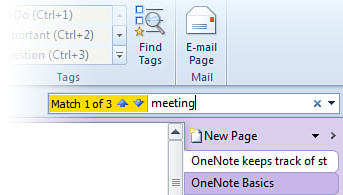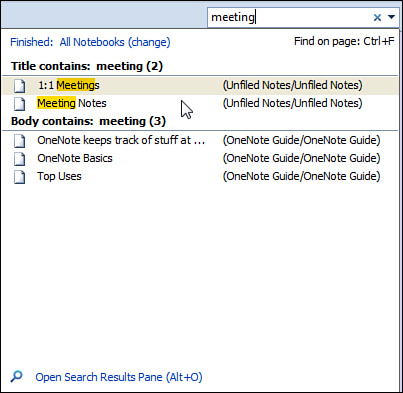Searching for Text on the Current Page
First, if the Tag Summary task pane is still shown
on the right side of the OneNote program window, close it by clicking
the X in the upper-right corner of the task pane. Although you can
search your notes with this pane visible, you’ll see that one of the
search features has its own task pane. To avoid confusion between the
two and save some screen real estate, closing the Tag Summary task pane
is a good idea.
Whenever you don’t need a full-blown search because
you know for certain that what you’re looking for is on the current
page you’re on, you can use OneNote’s quick Find on Page feature.
To search for text on the current page, do the following:
1. | If necessary, open or navigate to the page that you want to search.
|
2. | On your keyboard, press Ctrl+F (for Find).
|
3. | Near the right side of the OneNote program window just below the ribbon, look for the yellow Find on Page prompt (see Figure 2) and then type the word or phrase for which you want to search. For example, to find all occurrences of the word meeting, type meeting into the Search box (without quotes or punctuation).

|
4. | As
you type the search text, OneNote highlights all instances of it on the
current page. If the page has a large amount of text on it and it would
take a
while to scroll through the results, click the blue arrows that are
displayed in the Search box to step through the number of matches
OneNote has found in the text. Click the blue down arrow in the Search
box to go to the next match or click the up arrow to return to a
previous match. |
5. | When you’re done, press Esc.
|
|
If your practice notebook doesn’t yet have enough
sample notes content to try out the search features, you can either
switch to the Guide notebook that OneNote created when you started
OneNote for the first time and search for text there, or you can paste
a few paragraphs of text from another document or web page onto your
current notes page and then search for words that you know have at
least one or two matches. That way, you can see how search results show
up in a single page search.
|
Searching for Text with Instant Search
The second level of searching in OneNote is called
Instant Search. It is not limited to a single page but instead searches
through all of the notes in all of your notebooks. As the name
suggests, it does this instantly.
To start an Instant Search, do the following:
1. | On your keyboard, press Ctrl+E.
|
2. | OneNote
activates the Search box near the right side of the OneNote program
window and displays a pop-up window that represents a partial view of
all of the notebooks and sections you have available (see Figure 3). Any notes that contain the text you’re searching for will be highlighted in this list of notes.

|
3. | In
the Search box where the cursor is blinking, type a word or phrase to
search for. Note that, just below the Search box, the blue text
indicates that you’re currently searching for your text in all
notebooks. (If you want, you can click Change to change your search
scope by telling OneNote where to search.)
|
4. | As
with the single page search in the previous procedure, OneNote
instantly finds results based on every letter you type into the Search
box. Finish typing the search text until you find what you’re looking
for.
|
5. | When
OneNote has highlighted the result you want in the pop-up window, click
the result in the list, and OneNote will fetch the note containing the
matching search result.
|
6. | To
open the page containing one of the other matches, click its
highlighted search result in the list. When you’re done searching,
press Esc to dismiss the search interface.
|
You can initiate a new Instant Search at any time by
pressing Ctrl+E or by typing something into the Search box. Note that
every time you initiate a new search by pressing Ctrl+E, OneNote
automatically reverts to searching all available notebooks, even if you
changed the search scope in a previous search. If you want OneNote to
remember your preferred search scope selection, first click the word change
in the blue link under the Search box and narrow your search. For
example, to only search for results in the current section, you can
click This Section on the shortcut menu. Once you have selected a new
search scope, you can make it permanent by clicking the word change
in the blue link under the Search box once again and this time clicking
Set this Scope as Default on the shortcut menu. When you do this,
OneNote will remember your preference across sessions, which means that
if you shut down OneNote and run it again later, your first search
initiated with Ctrl+E or by typing into the Search box will be limited
to your previously selected search scope. You can change it back to All
Notebooks when you’re done limiting your searches to specific places.
|
The
functionality in the Search pop-up window isn’t limited to just
displaying your notebook structure or your matching search results. You
can click any item in the list to quickly navigate to that location and
review your notes there. However, only pages with occurrences of
matching search text will be highlighted in the pop-up window.
|